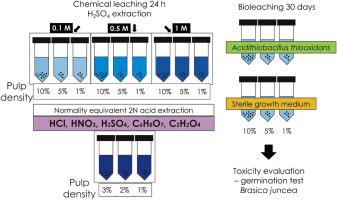Journal of Environmental Chemical Engineering ( IF 7.4 ) Pub Date : 2020-09-09 , DOI: 10.1016/j.jece.2020.104450 Anna Potysz , Artur Pędziwiatr , Sebastian Hedwig , Markus Lenz

|
Metallurgical wastes contain metals that are unrecovered during industrial processing. The disposal of these wastes is technically difficult due to the potential release of metals through weathering. Therefore, alternative management methods are currently sought. The high leaching susceptibility of these wastes combined with the need for alternative sources of rare and critical metals creates a need for residual element recovery. This study evaluated the leaching potential of lead matte and copper slag through chemical mineral acid leaching as well as indirect bioleaching with organic acids and direct bioleaching using Acidithiobacillus thiooxidans. The leaching efficiency of these acids was compared based on different normality equivalents. Additionally, the effects of pulp density (1–10%) and extraction time (24–48 h) were assessed. Slag toxicity was assessed with a germination test in concentrated and diluted leachates using Brassica juncea. The results demonstrated that copper slag is particularly suitable for chemical treatment because as much as 91 wt.% Cu and 85 wt.% Zn or 70 wt.% Cu and 81 wt.% Zn were extracted using HNO3 or bacterial leaching, respectively. The residual slag was characterized by significant metal depletion and the presence of gypsum, rendering it more suitable for further use or disposal. Lead matte released 65 wt.% Cu and 8 wt.% Zn using mineral acid leaching while 70 wt.% Cu and 12 wt.% Zn were released using bacterial leaching. Further process optimization is needed for lead matte to generate residue depletion in toxic metals. Toxicity assessment showed toxic characteristics in metal-loaded leachates originating from waste treatment that inhibited germination rates and root development.
中文翻译:

冶金废物的生物浸出和毒性
冶金废物所含金属在工业加工过程中无法回收。这些废物的处理在技术上是困难的,因为通过风化可能会释放出金属。因此,当前正在寻找替代的管理方法。这些废物的高浸出敏感性以及对稀有和关键金属的替代来源的需求导致了对残留元素回收的需求。这项研究评估了通过化学无机酸浸出以及有机酸间接生物浸出和使用硫代酸性氧化硫杆菌的直接生物浸出对铅哑铜和铜渣的浸出潜力。。根据不同的当量当量比较了这些酸的浸出效率。此外,评估了纸浆密度(1-10%)和提取时间(24-48 h)的影响。用发芽试验评估了芥菜浓缩液和稀释沥液中矿渣的毒性。结果表明,铜渣特别适合化学处理,因为使用HNO 3提取了多达91 wt。%的Cu和85 wt。%的Zn或70 wt。%的Cu和81 wt。的Zn或细菌浸出。残留炉渣的特征在于金属的大量消耗和石膏的存在,使其更适合于进一步使用或处置。使用无机酸浸出法,哑光铅释放了65 wt。%的Cu和8 wt。%Zn,而使用细菌浸出法释放了70 wt。%的Cu和12 wt。%Zn。铅哑光需要进一步的工艺优化,以在有毒金属中产生残留物消耗。毒性评估表明,金属废物浸出液中的毒性特征来自废物处理,从而抑制了发芽率和根系发育。











































 京公网安备 11010802027423号
京公网安备 11010802027423号